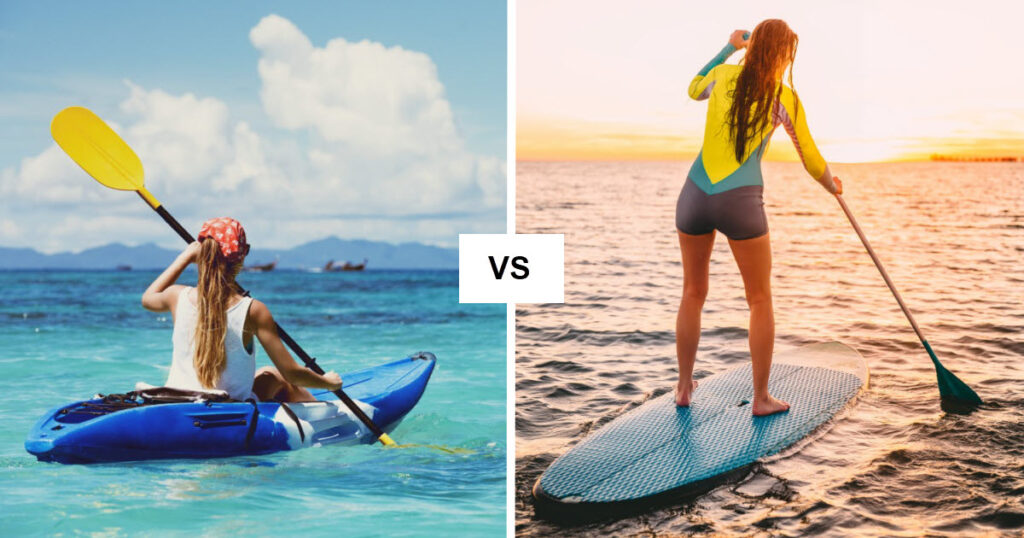Thinking about getting into watersports this summer? Kayaking and paddle boarding are two of the most popular options. Are you thinking about buying a kayak or a paddleboard, but you’re not sure which one to go with? You’ll find out everything you need to know in today’s kayak vs paddleboard comparison.
For paddling enthusiasts, choosing between a kayak and SUP can be tricky. Both are perfect for recreational water activities and getting an adrenaline rash.
Let’s start with my quick kayak vs paddleboard comparison overview.
Should You Choose a Kayak or a Paddleboard?
- Getting a kayak is best if you want durability, performance, and versatility to enjoy on outdoor adventures. In my view, it’s a better long-term investment and paddling option. It’s also what I recommend for paddlers with more limited mobility.
- Paddleboards, on the other hand, are an excellent option if you want to enjoy some leisurely activities, have limited storage space, or want to get started right away. With a paddleboard you don’t have to be as worried about proper form – it’s easy to learn to use a SUP as a beginner.
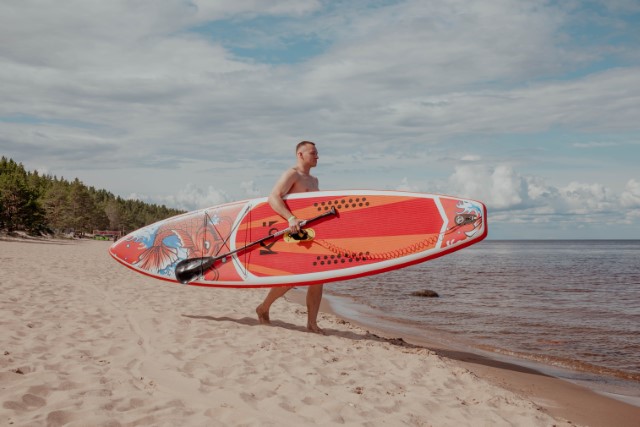
The article below will examine the differences between kayaks and paddleboards, what they are suitable for, and their pros and cons. This will give you a good idea of what to expect when getting your new craft for your water exploration.
Comparing Kayaks to Paddleboards
Here’s a quick kayak vs paddleboard comparison chart. You can use this to instantly understand the main differences between kayaks and paddleboards.
| KAYAK | PADDLEBOARD |
|---|---|
| Manufacturers make kayaks from wood, fiberglass, carbon fiber, polyethylene, or aramid materials. Inflatable kayaks use PVC. | Creating paddleboards involves using fiberglass, wood veneers, and epoxy resin, while inflatable boards use PVC. |
| Kayaks have a variety of hull shapes with an enclosed cockpit for paddlers to sit. Additionally, manufacturers make kayaks streamlined to cut through the water easily. | Paddleboards have flat stand-up deck designs meant for standing and paddling. The paddleboard creates more water resistance due to its relatively flat bottom. |
| Kayaks are larger. | Paddleboards are smaller. |
| Kayaks use a single double-bladed paddle or two single-bladed paddles for rowing. | Paddleboards use a single-bladed paddle to row. |
| You use them for both harsh and calm water activities. | You use them for light surfing and soft water activities. |
| Kayaks have high or low stability levels depending on their hull shape. | Paddleboards have a wide and flat platform for improved standing and paddling stability. |
| You sit in kayaks while paddling, providing more comfort. | SUPs offer more movement freedom, which can be comforting if you do not like confined spaces. |
| Kayaks are more maneuverable due to their shape, and riders use double-bladed paddles for propulsion. | The paddleboard’s flat shape and using a single-bladed reduces maneuverability. |
| Carrying around a kayak can be a hassle due to its bulk size and weight. | You can easily carry a paddleboard and inflatable SUP. |
| Kayaks are faster due to their streamlined shape and the added advantage of using two-bladed paddles. | Paddleboards’ flat shape creates more water resistance, and using single-bladed paddles reduces speed. |
| Kayaks’ hulls are large, taking up more space. | SUPs are flat and have an open deck, occupying less room while storing. |
| Kayaks encourage upper body workouts, including arms, shoulders, and core. | Paddleboards encourage a full-body workout, including upper and lower muscle exercising. |
Unique & Defining Features: Kayak vs Paddleboard
Before diving into my kayak vs paddleboard exploration, let’s take a closer look at what paddleboards and kayaks are. I’ll talk about the defining features that make them unique.
A Brief Look at Kayaks
You can picture a kayak as a small and slim canoeing boat. Kayaks have a cockpit where paddlers securely sit while riding and maneuvering through rough or calm water conditions.
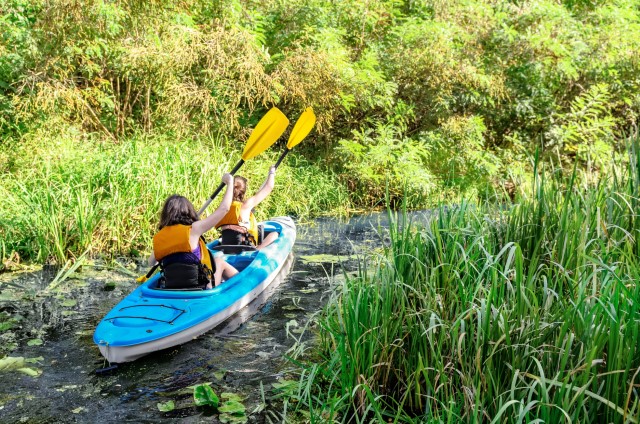
Before kayaks became a popular sporting craft, indigenous peoples in the Arctic and Aleutian Islands used them for hunting and traveling. For about 5,000 years, the Aluet and Inuit people used kayaks for traveling and fishing.
They made their watercrafts from wood, animal skin, and bone. They designed the vessels so that they were waterproof and would keep them warm during their expeditions.
Depending on the design and size, kayaks can accommodate up to three people, making them ideal for families or friends looking for an adventure. You can use a single two-bladed or two single-bladed paddles to row the kayak.
A Brief Look at Paddleboards
Paddleboards or standup paddleboards (SUPs) look like long surfing boards. Also referred to as “surf and cruise,” the boards are meant to surf small waves and enjoy gentle water activities in the lakes, rivers, or oceans.
You use the board by standing up on it and using a paddle to push the craft forward.

Hawaii and Peru were some of the first islands to use SUPs for fishing along the coasts. The natives used wood to make the boards and bamboo sticks for paddles.
Later on, the Peruvians later started using the boards to surf waves as a sport.
SUPs have become popular for water hobbyists looking to catch a few soft waves and enjoy lazy afternoon water activities. Due to its larger and wider surface, you can also bring a pet or child for your exploration.
Kayak vs Paddleboard (a complete comparison)
With an understanding of kayaks and paddleboards, let’s look at some noticeable differences between the two.
Materials
A kayak’s material and composition depend on its intended use.
If you’re just sticking to calm waters, you may be able to make do with a wooden kayak, as long as it’s well made.
However, you need a hardshell kayak made of a more durable substance (such as fiberglass, carbon fiber, polyethylene, and thermoform) for more challenging conditions.
On the other hand, manufacturers use a strong polymer-based fabric to create inflatable and folding kayaks.
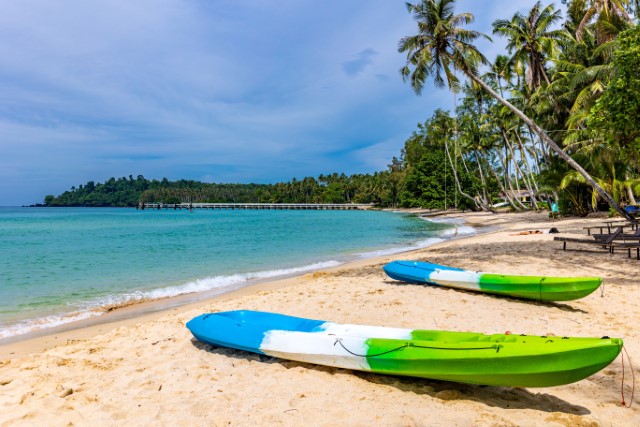
Just like kayaks, paddleboards come in two forms.
Paddleboard producers use a buoyant foam to make the board’s core. Afterward, a layer of wood veneer, carbon fiber, epoxy resin, or fiberglass covers the foam core for solid SUPS.
However, manufacturers use a PVC layer to cover the foam core in inflatable paddleboards. When it comes to material, choosing between the two depends on the durability and performance you need.
Design
How they’re designed is one of the most noticeable differences between kayaks and paddleboards.
Like the material from which a kayak is made, its hull and cockpit design determines its performance and stability. The hull design can affect your kayak’s speed and stability, as well as how easy it is to maneuver.
Kayaks with a flat hull tend to be more stable, while rounded hulls increase the kayak’s speed. V-shaped hulls are ideal for cutting through the water surface, achieving faster speeds and increased maneuverability.
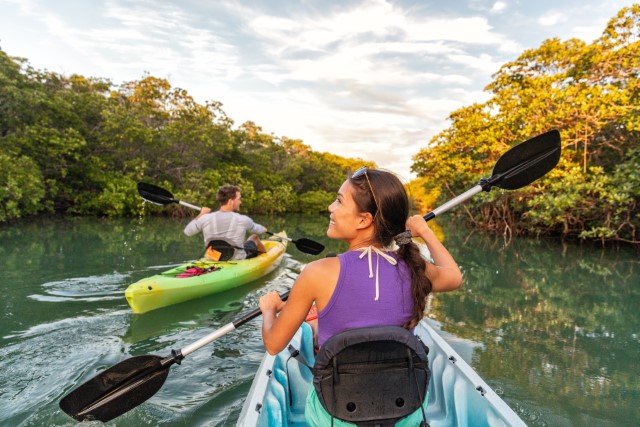
Furthermore, kayaks come with two cockpit designs: sit-on-top and sit-inside. Though both designs have seats, the difference is that sit-inside vessels have an enclosed cockpit.
Sit-inside kayaks have a footwell, protecting your feet from wind and water and keeping you warm. By contrast, sit-on-top has a mounted seat on the deck.
SUPs have a simpler design than kayaks.
They don’t have any internal space, and you stand or place cargo on the board.
An SUP has a large, wide, thick deck for better stability while standing or performing water activities like surfing.
Paddleboards have a flat bottom to increase the craft’s upthrust for more buoyancy. However, the back of the board has a tail to improve maneuverability while paddling and surfing small waves.
So, kayaks take the win in terms of design as they have multiple options for your choosing.
Size
Kayaks tend to be longer due to their hull size and shape. They have additional foot support and storage, increasing their hull size.
Most hardshell kayaks are about 10 feet long but range in size from 6-17 feet, depending on their intended use.
A kayak’s width determines its stability and affects its speed. Most kayaks are about 22-23 inches wide.
Wider kayaks offer more stability and are ideal for fishing and other gentle water activities, while narrower crafts sacrifice stability for better speed.
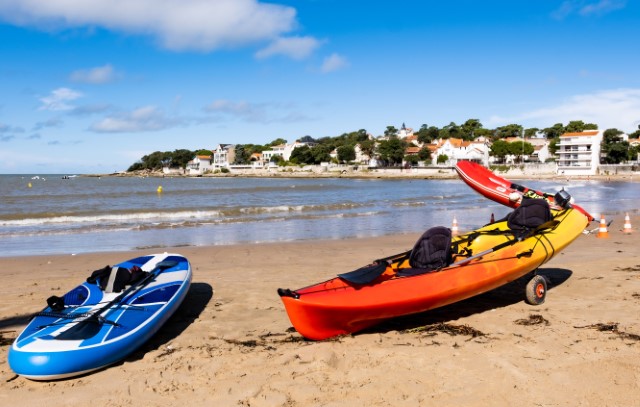
Surfers prefer SUPs for their stability because they have a larger and wider deck. Most boards are about 32-34 inches wide.
You can opt for a wider paddleboard, but you might have to compromise on the vessel’s speed.
Popular paddleboards are usually about 8-12 feet long. The short length provides better board stability while standing and paddling.
Buying a paddleboard should be an excellent decision if you want a small-size watercraft for your adventures.
Paddle Design and Technique
You probably also wonder what kinds of paddles you need for both watercrafts.
For the SUPs, you will require a single-bladed paddle to propel the craft before catching a wave to ride.
Paddling a SUP comes easy for most people, but if you still lack confidence, you can paddle while kneeling or sitting on the board. This is also useful if you bring your child or pet for an adventure.
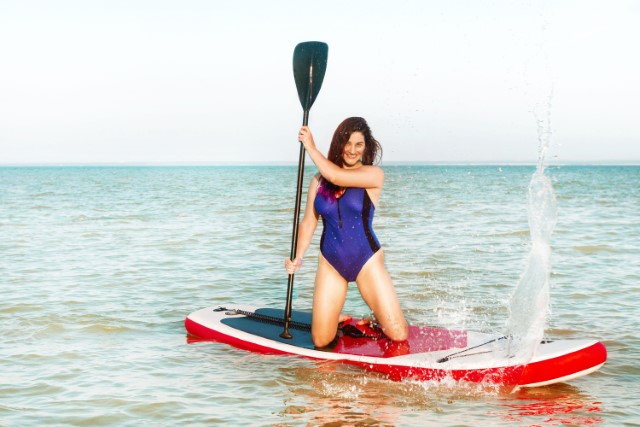
Likewise, you can use your hands for paddling when you lose your paddle or just want a nice feel of the water on a hot afternoon.
However, kayaks have a variety of paddle designs and techniques that you can use on your water excursion. You can use a double-bladed paddle or two single-bladed paddles to row on each side of the craft.
Both paddle designs provide better maneuverability and faster reaction, enhancing the kayak’s speed.
Kayaks also offer a variety of styles and configurations. The type of kayak you choose will affect your paddling techniques.
If you don’t want to kayak by yourself, you can get tandem kayaks.
If you are considering paddling techniques, getting a kayak should be on your list.
Performance and Versatility
Kayaks are ideal for any kind of water conditions, including white water rafting, surfing, or a simple fishing trip with friends.
Manufacturers make kayaks for water sports and activities. The manufacturers optimize the kayak’s hull for more efficient movement on your adrenaline adventure.
The hull’s shape ensures the kayak can cut through waves while still maintaining course and without reducing speed.
As I previously stated, kayaks provide better paddling efficiency. Double-bladed or two single-bladed paddles provide better propulsion and faster reaction when making tight turns under harsh water conditions.
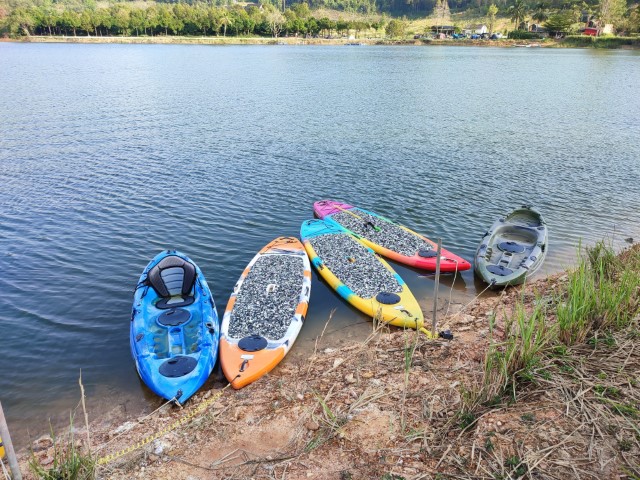
On the other hand, paddleboards are good at handling soft wave surfing and gentle water activities.
You will have a fun recreational afternoon near the calm coastal line or river on a paddle board. The SUPs are excellent for slow currents while paddling, fishing, slow tours, or yoga.
Though you can ride a few waves, paddleboards cannot handle harsh water conditions and rafting.
Kayaks take the win for better performance and versatility while on your water adventure.
Stability
For most enthusiasts, standup paddleboards are ideal for stability. As we previously saw, SUPs have a wide and flat deck that ensures you can stand and paddle without issues.
More surface area ensures you can distribute your weight evenly on the board, enhancing stability in calm water conditions.
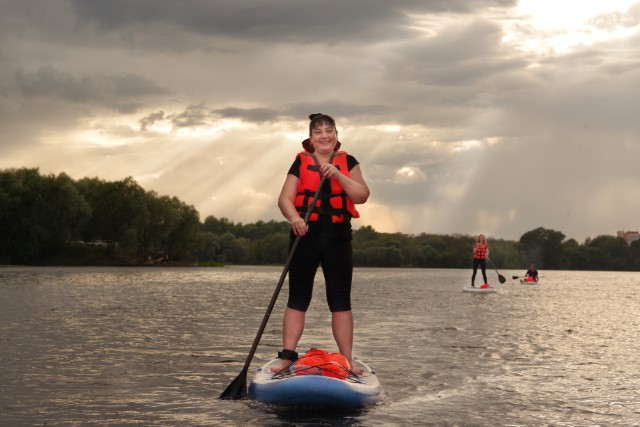
On the other hand, the narrow hull design in kayaks can prove challenging for most beginners. Kayaks have a hydrodynamic hull meant to slice the water surface, reducing their stability.
However, if you remove the hull’s shape, kayaks offer more stability because you sit on the craft. You have a lower center of gravity seated, improving your stability.
In the stability race, paddleboards take the lead due to their wide and large platform. However, kayaks also give experienced paddlers an edge due to their lower center of gravity.
Comfort
Standup paddleboards are ideal for better visibility while surfing or performing other water activities.
Likewise, if you do not like feeling restricted or confined, SUPs might be ideal. They provide more freedom to move around.
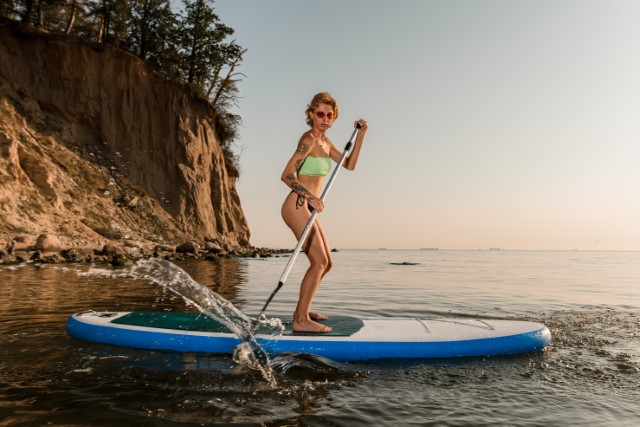
However, long-distance trips and harsh waters can make a lot of difference.
The kayak seat can reduce fatigue, especially if you take long-distance rides. Additionally, when faced with rough waves and currents, the kayak provides better protection, reducing stress levels.
Considering your safety, protection, and fatigue, kayaks would be more comfortable in the long run.
Maneuverability
The different hull shapes in kayaks give them a particular edge when it comes to maneuverability.
As I previously stated, depending on your required performance, you can choose among the flat, rounded, and V-shaped hulls. However, V-shaped hulls offer the best flexibility when making turns, especially in rough waters.
Additionally, having more paddle configurations and techniques enhances how well you maneuver around the water. More paddling and rowing stroke options can reduce strain and fatigue when using a kayak.
Paddleboards, on the other hand, have a wide and large deck meant for stability. The downside is more stability comes with reduced maneuvering capabilities through harsh waves or rough water conditions.
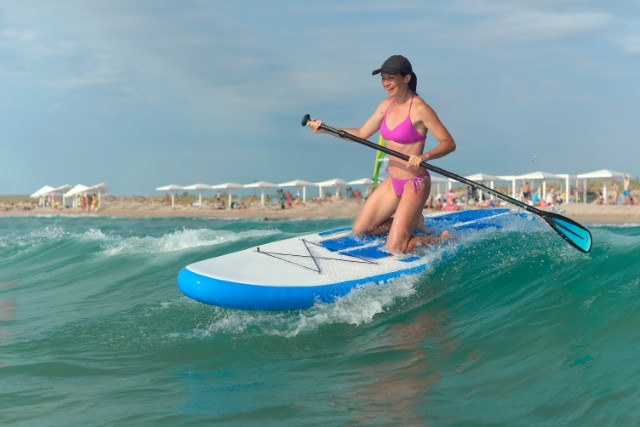
Likewise, standup paddleboards only use a single-bladed paddle for propulsion.
Using a single paddle might require constantly switching hands to keep the board on the right course. This can hinder your movement flexibility and requires more energy, which can be exhausting.
When it comes to maneuverability, you better opt for a kayak.
Ease of Use
Though kayaks are easy to use, they require you to learn more skills before rafting or surfing waves. Additionally, stability issues might make it hard to get in or out of the vessels.
If a kayak flips, there is a risk of getting stuck in the cockpit, and you might also have an issue getting back into it.

Paddleboards have excellent stability, which makes them easier to use. You can stand, sit, or do water yoga without worrying too much about the board flipping over. Furthermore, paddling is effortless, especially when dealing with calm water.
For this reason, paddleboards are easier to use, especially if you are a beginner.
Portability
Transporting a kayak can be a huge hassle due to its size and weight. Kayaks weigh about 20 pounds (9kg) to 100 pounds (45kg), depending on their materials, intended use, and the number of paddlers.
Before taking it out to the river or lake, you need a kayak trailer or you’ll load your kayak on the roof rack on your car.
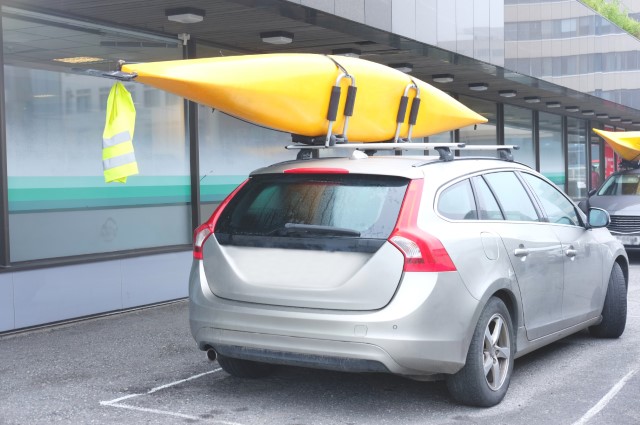
You might also need some help moving the kayak into the water. However, inflatable and folding kayaks are still available if you want a more portable vessel.
On the other hand, SUPs are smaller in size and less bulky than kayaks. They weigh about 15 pounds (7kg) to 40 pounds (18 kg). Their weight depends on their size and the materials used to make them.
Though you might still need a roof rack on your car, you can unmount the board and carry it yourself.
So, if portability is what you are looking for, paddleboards are the best way to go.
Speed
A kayak’s design gives it an overall edge when building speed. Tapered hulls cut through the water easier, creating less resistance when paddling.
On average, kayaks can reach a speed of around five miles per hour, while the highest speed recorded is 39 miles per hour.
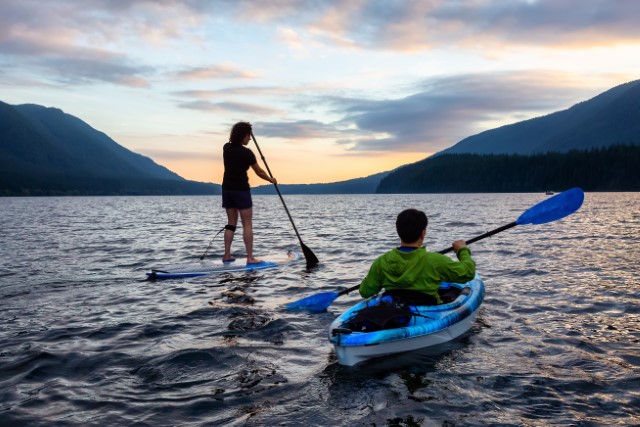
On the other hand, paddleboards sacrifice speed for stability. The rounded nose and wide neck create more water resistance making them slow.
On average, an SUP achieves a speed of about 3-4 miles per hour, while the specialized racing boards can reach about 9 miles per hour.
The reason for the speed disparity depends on the craft’s make, design, size, paddle-centric conditions, water flow, and weather conditions. Your stamina and skill will also affect the overall watercraft speed.
However, overall, kayaks can achieve higher average speeds than paddleboards.
Easy Storage
As we saw before, kayaks are larger and longer. Hard shell kayaks can be extremely challenging to store if you do not have ample space in your garage or shed.
On the other hand, inflatable and foldable kayaks take up less space.
SUPs are smaller and do not have a large hull, taking up less volume while storing. You can easily store the board around the house or shed.
Standup paddleboards take the win if you are looking for easy storage around the house.
Paddling for Fitness
If you want to burn more calories, kayaking is an excellent choice. Primarily, kayaking helps improve upper-body fitness.
Paddling engages muscles in your hands, shoulders, back, and core.
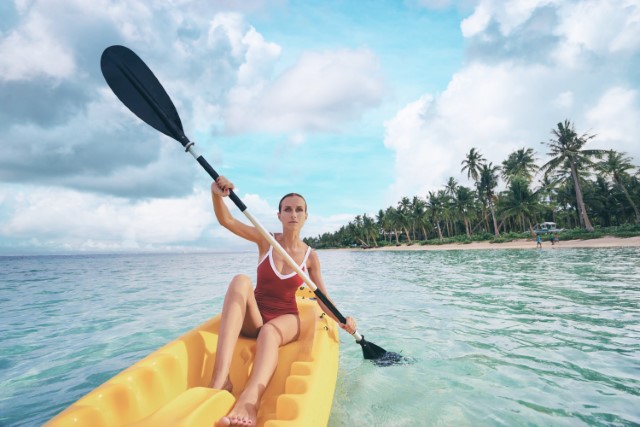
Kayaking can be strenuous for most beginners. If you are new to paddling, it can be exhausting to paddle through the water. Therefore, a little fitness can be a huge advantage before picking up the sport.
On the other hand, paddle boarding is a great way to engage both your upper and lower muscles.
While paddling through the water, you exercise your hands and shoulders. Standing engages your core and leg muscles to keep you stable on the board.
Likewise, SUPs only need a little experience when you start. Paddle boarding is suitable for people of all ages and fitness levels.
You can also perform other forms of relaxing exercise like yoga on the board.
Paddleboards take the win due to their versatile fitness benefits.
EDITOR’S NOTE: If you want a complete comparison of calories burned kayaking and calories burned paddle boarding, I have articles on each of those subjects. Each article has a calorie calculator for the sport for you to use.
Pros and Cons of Kayaks and Paddleboards
Now that you understand the differences in functionality and performance between the two crafts, let us look at their benefits and drawbacks.
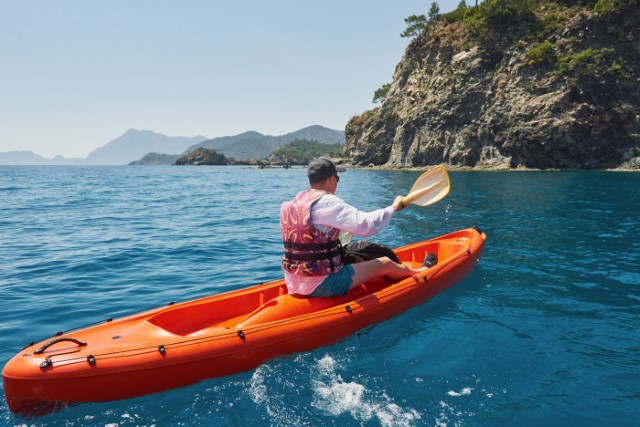
| KAYAKING PROS |
- Kayaks provide excellent protection due to their enclosed cockpit.
- Kayaks are faster than standup paddles due to their design and paddle configuration, which can help you cover longer distances.
- Kayaks also have several paddler options.
- Kayaks have a higher load capacity.
- They are also more versatile and can ride rough and calm water conditions.
- Kayaks are more maneuverable than SUPs due to their narrow hull and paddle configuration.
- The crafts are excellent to burn more calories and work on your upper-body strength.
| KAYAKING CONS |
- Restricted movement can make it uncomfortable for you.
- Learning how to kayak can take time and require some particular skills.
- Kayaks, especially hard-shell kayaks, can be bulky, making them less portable and taking up much storage space.
- They are also less stable than paddleboards due to their hull shape and design.
- Kayaking is not versatile if you are looking for all-around fitness.
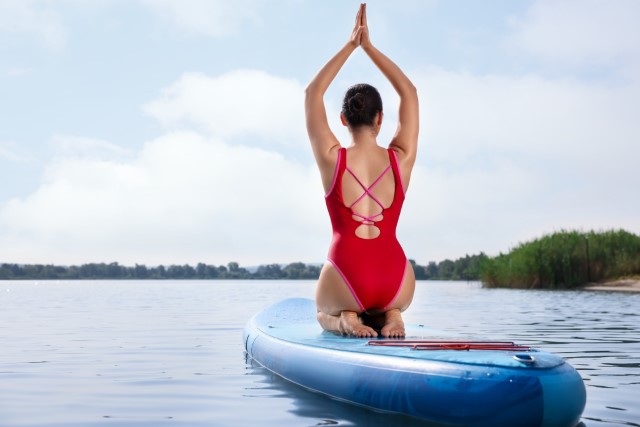
| PADDLE BOARDING PROS |
- Paddleboards are lighter and shorter than kayaks, making them easy to carry and store.
- They are also more stable, which makes them easy to master and more user-friendly for beginners.
- They are more comfortable if you are looking for fewer paddling restrictions.
- SUPs are ideal for less-strenuous water activities like yoga.
- Paddleboards are suitable for all-around fitness
| PADDLE BOARDING CONS |
- Though paddleboards have better stability, they are slower than kayaks.
- They have less paddle configuration, which reduces their performance efficiency.
- SUPs are less maneuverable due to their design.
- They have a limited load capacity, meaning you can only carry a few objects or people on board.
Final Thoughts About Choosing Between a Kayak vs SUP
Kayaks and SUPs are excellent for water sports and activities. However, before buying one, here is a quick summary of some factors you should consider.
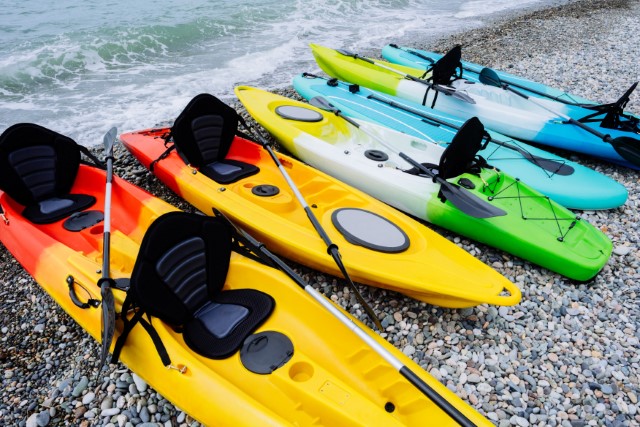
Kayaks are more versatile due to their hull shape, which improves their performance and speed. They also have more paddling configurations that improve maneuverability while rowing.
Additionally, kayak cockpits provide safety to you while paddling.
Paddleboards have better stability due to their flat deck design. They are also shorter and less heavy, making them easy to carry and store.
SUPs have a shorter learning curve and are suitable for people of all ages and skill levels.
And there you have it! I hope my kayak vs paddleboard comparison helps you make the right decision.

